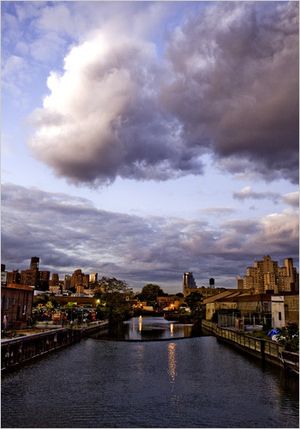
In this Sunday's NY Times Magazine, an article about the Gowanus Canal. Here an excerpt:
"THE GOWANUS CANAL runs one and a half miles through brownstone Brooklyn,
cutting a disreputable gash between two of the most desirable
residential neighborhoods in New York City. Sunken below street level,
no more than 100 feet across at most points, the canal does not really
flow — it skulks. On sunny days, its waters take a greenish hue and are
clear enough to afford glimpses of rotting bulkhead timbers, mud-caked
tires and other submerged detritus. When it’s overcast, the water turns
an inert gray. In the lawless old days, industries along the canal’s
banks fouled it with all kinds of pollution. Today, the canal is mostly
disused, a corridor of warehouses and razor wire, and the most enduring
reminders of its colorful past emanate from several underground
deposits of coal tar, which belch up oily bubbles. The residue forms a
prismatic sheen on the canal’s surface, reflecting shimmering visions
of the landscape."
cutting a disreputable gash between two of the most desirable
residential neighborhoods in New York City. Sunken below street level,
no more than 100 feet across at most points, the canal does not really
flow — it skulks. On sunny days, its waters take a greenish hue and are
clear enough to afford glimpses of rotting bulkhead timbers, mud-caked
tires and other submerged detritus. When it’s overcast, the water turns
an inert gray. In the lawless old days, industries along the canal’s
banks fouled it with all kinds of pollution. Today, the canal is mostly
disused, a corridor of warehouses and razor wire, and the most enduring
reminders of its colorful past emanate from several underground
deposits of coal tar, which belch up oily bubbles. The residue forms a
prismatic sheen on the canal’s surface, reflecting shimmering visions
of the landscape."
